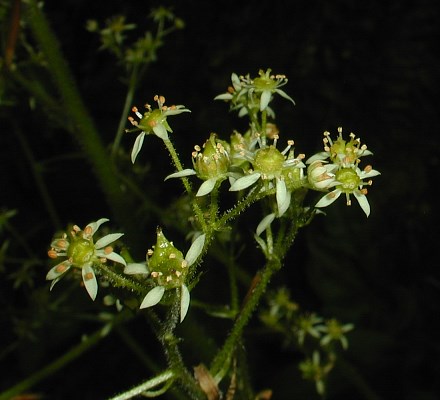Description: This wildflower consists of a rosette of basal leaves and a flowering stalk about 1-3' tall. Individual basal leaves are up to 9" long and 3" across; they are oblong to ovate-oblong, crenate or smooth along their margins, and medium green. Basal leaves are glabrous to sparsely hairy on their upper surfaces, while their lower surfaces are sparsely to moderately hairy. Generally, young leaves are more hairy than older leaves. The inflorescence consists of a panicle of flowers, which develops from an erect central stalk. This stalk is fairly stout, terete, and densely covered with spreading hairs. The panicle is ellipsoid in shape, ½–1½' long, and about 1/3 as much across when it is fully extended. The branches of the panicle are ascending to spreading and usually pubescent. There is a single linear-lanceolate bract at each major fork of the branches. Depending on the size of the inflorescence, the flowers vary in abundance; they usually bloom at about the same time. Each flower is ¼" across, consisting of 5 narrow white petals, 5 green sepals that are joined together at the base, 10 stamens with white to orange-brown anthers, and 2 prominent pistils that are green and joined together. The sepals are triangular in shape and become recurved when the flowers bloom. The petals are longer than the sepals. The blooming period occurs during the late spring for 2-3 weeks. Each flower is replaced by a pair of beaked follicles; each follicle splits open along one side to release its seeds. The root system consists of a crown of fleshy fibrous roots and rhizomes. Clonal offsets from the rhizomes are often formed.

Cultivation:
The
preference is light shade to partial sun, consistently moist
conditions, high humidity, and thin rocky soil containing sandstone.
The site should be protected from prevailing winds.
Range & Habitat:
The native Forbe's Saxifrage is found in southern Illinois (where it is
uncommon)
and 3 counties in northern Illinois, where it is rare; it is absent
from the remaining areas of the state (see Distribution
Map). This map excludes the distribution of the more common
typical variety, Saxifraga pensylvanica pensylvanica
(Swamp Saxifrage). Habitats are largely restricted to the lower slopes
of rocky bluffs (usually north-facing), moist ledges along sandstone
ravines, and the lower slopes of sandstone canyons, particularly where
some seepage of moisture occurs. These habitats are always found in
wooded areas with varying amounts of shade. Forbe's Saxifrage is
restricted to high quality natural areas.
Faunal Associations:
The flowers are cross-pollinated primarily by small bees, wasps, and
various flies. Less common visitors include sawflies and beetles. These
insects usually suck nectar, although some of the bees also collect
pollen, while some flies and beetles prefer to feed on the pollen.
These observations are from Graenicher.

Photographic
Location:
Lower slope of a sandstone canyon at the Portland Arch in west-central
Indiana.
Comments:
I have selected Vasey's taxonomic classification of Forbe's Saxifrage.
This is something of a compromise. Some botanists in Illinois and
Indiana (e.g., Mohlenbrock, 2002) classify Forbe's Saxifrage as a
separate species, Saxifraga forbesii, rather than a
variety of Saxifraga pensylvanica (Swamp
Saxifrage). Other botanists don't recognize Forbe's Saxifrage at even
the varietal level. Generally, Forbe's Saxifrage is supposed to have
hairier basal leaves than Swamp Saxifrage, and the petals of its
flowers are longer than the sepals. Swamp Saxifrage is supposed to have
slightly smaller flowers, where the petals are about the same length as
the sepals. Swamp Saxifrage is found primarily in the northern half of
Illinois, where it is found in both sunny and shaded wetlands. The only
other Saxifrage in Illinois is Saxifraga virginiensis
(Early Saxifrage), which has been found only in Hardin County. This
latter species is much smaller in size; it prefers drier upland areas
and can bloom as early as mid-spring.